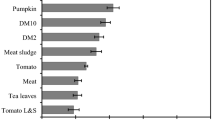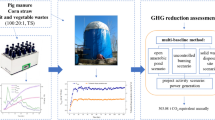Abstract
Agro-industrial waste represents a major challenge for the environment. Among these, the processing of peppers generates a large amount of waste, so the search for new ways to valorise this waste is crucial. This work aims to assess the use of pepper waste for methane production with swine manure. During this study, anaerobic co-digestion was evaluated in both batch and semi-continuous operation. Specifically, batch assays were performed following a factorial design to study the effect of the initial substrate concentration and the percentage of pepper waste on methane yield and on volatile solid removal. In these assays, the highest specific methane yield was 309 NmL g VS−1 obtained at 2.5 g VS L−1 and 50% of pepper waste in the feed. Under semi-continuous operation, anaerobic co-digestion improved the methane yield up to 86% in comparison to the mono-digestion of swine manure. In addition, the economic assessment showed the viability of the process with positive indices of the anaerobic co-digestion of pepper waste and swine manure. These results proved that the anaerobic co-digestion of these substrates can be a technically and economically viable alternative for its valorisation.



Similar content being viewed by others
References
Ros M, Pascual JA, Ayuso M, Morales AB, Miralles JR, Solera C (2012) Salidas valorizables de los residuos y subproductos orgánicos de la industria de los transformados de frutas y hortalizas: proyecto Life + Agrowaste. Residuos: Revista Técnica 22:28–35
Vulic J, Seregelj V, Kalusevic A, Levic S, Nedovic V, Saponjac VT, Canadanovic-Brunet J, Cetkovic G (2019) Bioavailability and bioactivity of encapsulated phenolics and carotenoids isolated from red pepper wastes. Molecules 24:2837
Ferrer P, Cambra-López M, Cerisuelo A, Peñaranda DS, Moset V (2014) The use of agricultural substrates to improve methane yield in anaerobic co-digestion with pig slurry: effect of substrate type and inclusion level. Waste Manag 34:196–203
Maia AAD, de Morais LC (2016) Kinetic parameters of red pepper waste as biomass to solid biofuel. Bioresour Technol 204:157–163
Akman HE, E. Akman AS, Ciggin NA, Perendeci, NA, Yaldız O, (2015) Effects of mixture ratio of cow manure and greenhouse wastes on anaerobic co-digestion process. Agric Eng Int :CIGR J Special Issue 2015:160–167
Banks CJ, Humphreys PN (1998) The anaerobic treatment of ligno-cellulosic substrate offering little natural pH buffering capacity. Water Sci Technol 38(4/5):29–35
Gladchenko MA, Kovalev DA, Kovalev AA, Litti YV, Nozhevnikova AN (2017) Methane production by anaerobic digestion of organic waste from vegetable processing facilities. Appl Biochem Micro 53(2):242–249
Molinuevo-Salces B, García-González MC, González-Fernández C, Cuetos MJ, Morán A, Gómez X (2010) Anaerobic co-digestion of livestock wastes with vegetable processing wastes: a statistical analysis. Bioresour Tecnol 101:9479–9485
Angelidaki I, Ahring B (1997) Anaerobic digestion in Denmark. Past present and future. III Cud´ Enginyeria Ambiental Lleida, pp. 336–342.
Molnar L, Bartha I (1998) High solids anaerobic fermentation for biogas and compost production. Biomass 16:173–182
Bujoczek G, Oleszkiewicz J, Sparling R, Cenkowski S (2000) High solid anaerobic digestion of chicken manure. J Agr Eng Res 76:51–60
JrB M, Adams TT, Johnston P (2001) Anaerobic co-digestion of hog and poultry waste. Bioresour Technol 76:165–168
Hartmann H, Angelidaki I, Ahring BK (2003) Co-digestion of the organic fraction of municipal waste types. In: Mata-Álvarez J (ed) Biomethanization of the Organic Fraction of Municipal Solid Wastes. IWA Publishing, UK
Martínez-García G, Johnson AC, Bachmann RT, Williams CJ, Burgoyne A, Edyvean RGJ (2007) Two-stage biological treatment of olive mill wastewater with whey as co-substrate. Int Biodeter Biodegr 59:273–282
Chong ML, Rahman NA, Rahim RA, Aziz SA, Shirai Y, Hassan MA (2009) Optimization of biohydrogen production by Clostridium butyricum EB6 frompalm oil mill effluent using response surface methodology. Int J Hydrogen Energy 34:7475–7482
Montgomery DC (2017) Design and analysis of experiments, 9th edn. John Wiley & Sons Inc., New York, NY
Colleran E, Concannon F, Golde T, Geoghegan F, Crumlish B, Killile E, Henry M, Coates J (1992) Use of the methanogenic activity tests to characterize anaerobic sludges, screen for anaerobic biodegradability and determine toxicity thresholds against individual anaerobic trophic groups and species. Water Sci Technol 25:31–40
Holliger C, Alves M, Andrade D, Angelidaki I, Astals S, Baier U, Bougrier C, Buffière P, Carballa M, De Wilde V, Ebertseder F, Fernández B, Ficara E, Fotidis I, Frigon JC, De Laclos HF, Ghasimi DSM, Hack G, Hartel M, Heerenklage J, Horvath IS, Jenicek P, Koch K, Krautwald J, Lizasoain J, Liu J, Mosberger L, Nistor M, Oechsner H, Oliveira JV, Paterson M, Pauss A, Pommier S, Porqueddu I, Raposo Bejines F, Ribeiro T, Pfund FR, Strömberg S, Torrijos M, Van Eekert M, Van Lier J, Wedwitschka H, Wierinck I (2016) Towards a standardization of biomethane potential tests. Water Sci Technol 74(11):2515–2522
Pellera FM, Gidarakos E (2017) Anaerobic digestion of solid agroindustrial waste in semi-continuous mode: evaluation of mono-digestion and co-digestion systems. Waste Manag 68:103–119
Bres P, Beily ME, Young BJ, Gasulla J, Butti M, Crespo D, Candal R, Komilis D (2018) Performance of semi-continuous anaerobic co-digestion of poultry manure with fruit and vegetable waste and analysis of digestate quality: a bench scale study. Waste Manag 82:276–284
APHA (2005) Standards methods for the examination of water and wastewater, 21st edn. American Public Health Association, American Water Works Association, Water Environment Federation, Washington, DC
UNE-EN 16948 (2015) Standard for biomass analysis. Biocombustibles sólidos, Determinación de contenido total de C, H y N. Método instrumental.
Buchauer K (1997) Titrations verfahren in der Abwasserund Schlam-manalytik zur Bestimmung von flüchtigen organischen Säuren”. Das Gas- und Wasserfach (gfw). Wasser Abwasser 138(6):313–320
Zahan Z, Othman MZ, Muster TH (2018) Anaerobic digestion/co digestion kinetic potentials of different agroindustrial wastes: a comparative batch study for C/N optimisation. Waste Manag 71:663–674
Alqaralleh RM, Kennedy K, Delatolla R (2018) Improving biogas production from anaerobic co-digestion of Thickened Waste Activated Sludge (TWAS) and fat, oil and grease (FOG) using a dual-stage hyper-thermophilic/thermophilic semi-continuous reactor. J Environ Manag 217:416–428
Lo Guzzo D (2017) Diseño de un digestor de fangos anaerobio con producción de biogás. Estudio de cogeneración (Doctoral dissertation; in Spanish).
Imeni SM, Pelaz L, Corchado-Lopo C, Busquets AM, Ponsá S, Colón J (2019) Techno-economic assessment of anaerobic co-digestion of livestock manure and cheese whey (Cow, Goat & Sheep) at small to medium dairy farms. Bioresour Technol 291:121872
Sarpong GM, Gude VG (2021) Codigestion and combined heat and power systems energize wastewater treatment plants–analysis and case studies. Renew Sust Energ Rev 144:110937
MARM (2010) El sector del biogás agroindustrial en España. Ministerio de Medio ambiente y Medio Rural y Marino, https://www.mapa.gob.es/es/ganaderia/temas/requisitos-y-condicionantes-de-la-produccion-ganadera/DOCBIOGASVersion21-09-2010_tcm30-110139.pdf Accessed 10 December 2020.
Riaño B, García-González MC (2016) Chapter 52 Solid-liquid separation. In: Bernal et al. Evaluation of manure management Systems. Edited by: Sarga, Zaragoza (Spain), pp- 60–67
Yagüe MR, Lobo MC (2020) Liquid digestate features as fertilizer: carbon fractions, phytotoxicity and microbiological analysis. Span J Soil Sci 10(3):248–256
Khoshnevisan B, Tsapekos P, Alfaro N, Díaz I, Fdz-Polanco M, Rafiee S, Angelidaki I (2017) A mini review on prospects and challenges of biological H2S removal from biogas with focus on biotrickling filtration and microaerobic desulfurization. Biofuel Res J 16:741–750
Flotats X, Campos E, Palatsi J, Bonmatí X (2001) Digestión anaerobia de purines de cerdo y co-digestión con residuos de la industria alimentaria. Porci; Monografías de actualidad 65:51–65
Zhou J, Zhang R, Liu F, Yong X, Wua X, Zheng T, Jiang M, Jia H (2016) Biogas production and microbial community shift through neutral pH control during the anaerobic digestion of pig manure. Bioresour Technol 217:44–49
Shi X, Zuo J, Zhang M, Wang Y, Yu H, Li B (2019) Enhanced biogas production and in situ ammonia recovery from food waste using a gas-membrane absorption anaerobic reactor. Bioresour Technol 292:121864. https://doi.org/10.1016/j.biortech.2019.121864
Yenigün O, Demirel B (2013) Ammonia inhibition in anaerobic digestion: a review. Process Biochem 48:901–911
Chen S, Zhang J, Wang X (2015) Effects of alkalinity sources on the stability of anaerobic digestion from food waste. Waste Manage Res. https://doi.org/10.1177/0734242X15602965
Angelidaki I, Sanders W (2004) Assessment of the anaerobic biodegradability of macropollutants. Rev Environ Sci Biotechnol 3:117–129. https://doi.org/10.1007/s11157-004-2502-3
Nielfa A, Cano R, Fdz-Polanco M (2015) Theoretical methane production generated by the co-digestion of organic fraction municipal solid waste and biological sludge. Biotechnol Reports 5:14–21. https://doi.org/10.1016/j.btre.2014.10.005
Parralejo AI, Royano L, González J, González JF (2019) Small scale biogas production with animal excrement and agricultural residues. Ind Crop Prod 131:307–314
Zarkadas IS, Zachariou S, Stamou I, Kaldis FV, Lioti M, Sarigiannis DA (2019) Anaerobic digestion of olive mill wastewater: focusing on the effect of nitrogen source. Clean—Soil Air Water 47:1800300
Parralejo AI (2020) Cultivos energéticos y residuos agro-ganaderos como sustratos para optimizar el potencial de generación de biogás en procesos de digestión anaerobia. Universidad de Extremadura, Badajoz
Dareioti MA, Kornaros M (2015) Anaerobic mesophilic co-digestion of ensiled sorghum, cheese whey and liquid cow manure in a two-stage CSTR system: effect of hydraulic retention time. Bioresour Technol 175:553–562
Bonmati A, Flotats X, Mateu L, Campos E (2001) Study of thermal hydrolysis as a pre-treatment to mesophilic anaerobic digestion of pig slurry. Water Sci Technol 44:109–116
Rodríguez-Verde I, Regueiro L, Carballa M, Hospido A, Lema JM (2014) Assessing anaerobic co-digestion of pig manure with agroindustrial wastes: the link between environmental impacts and operational parameters. Sci Total Environ 497–498:475–483
Valenti F, Liao W, Porto SMC (2020) Life cycle assessment of agro-industrial by-product reuse: a comparison between anaerobic digestion and conventional disposal treatments. Green Chem 22:7119
Funding
This work has been funded by the National Institute of Research and Agro-Food Technology (INIA) and co-financed with FEDER funds (Projects RTA2015-00060-C04-01 and PID2019-106148RR-C41) and for the EU Program INTERREG V-A Spain – Portugal (POCTEP) 2014–2020 (Project 0745_SYMBIOSIS_II_3_E).
Author information
Authors and Affiliations
Corresponding author
Additional information
Publisher's note
Springer Nature remains neutral with regard to jurisdictional claims in published maps and institutional affiliations.
Supplementary Information
Below is the link to the electronic supplementary material.
Rights and permissions
About this article
Cite this article
Riaño, B., Molinuevo-Salces, B., Parralejo, A. et al. Techno-economic evaluation of anaerobic co-digestion of pepper waste and swine manure. Biomass Conv. Bioref. 13, 7763–7774 (2023). https://doi.org/10.1007/s13399-021-01831-0
Received:
Revised:
Accepted:
Published:
Issue Date:
DOI: https://doi.org/10.1007/s13399-021-01831-0




